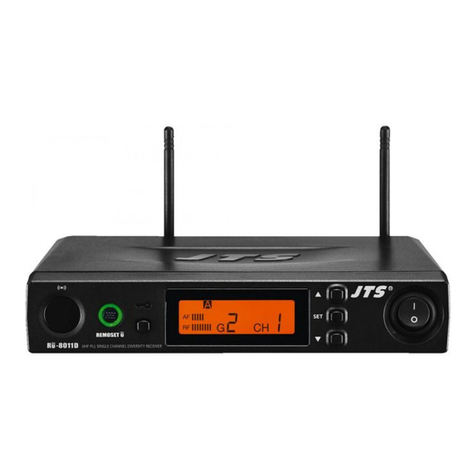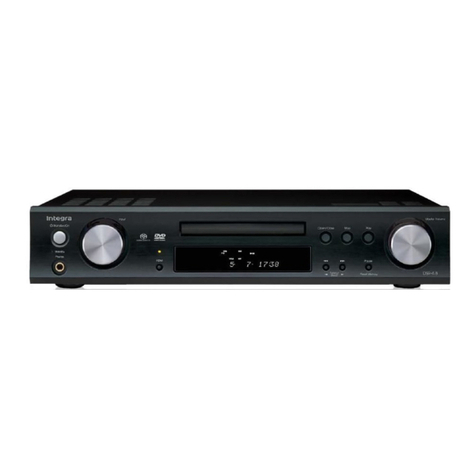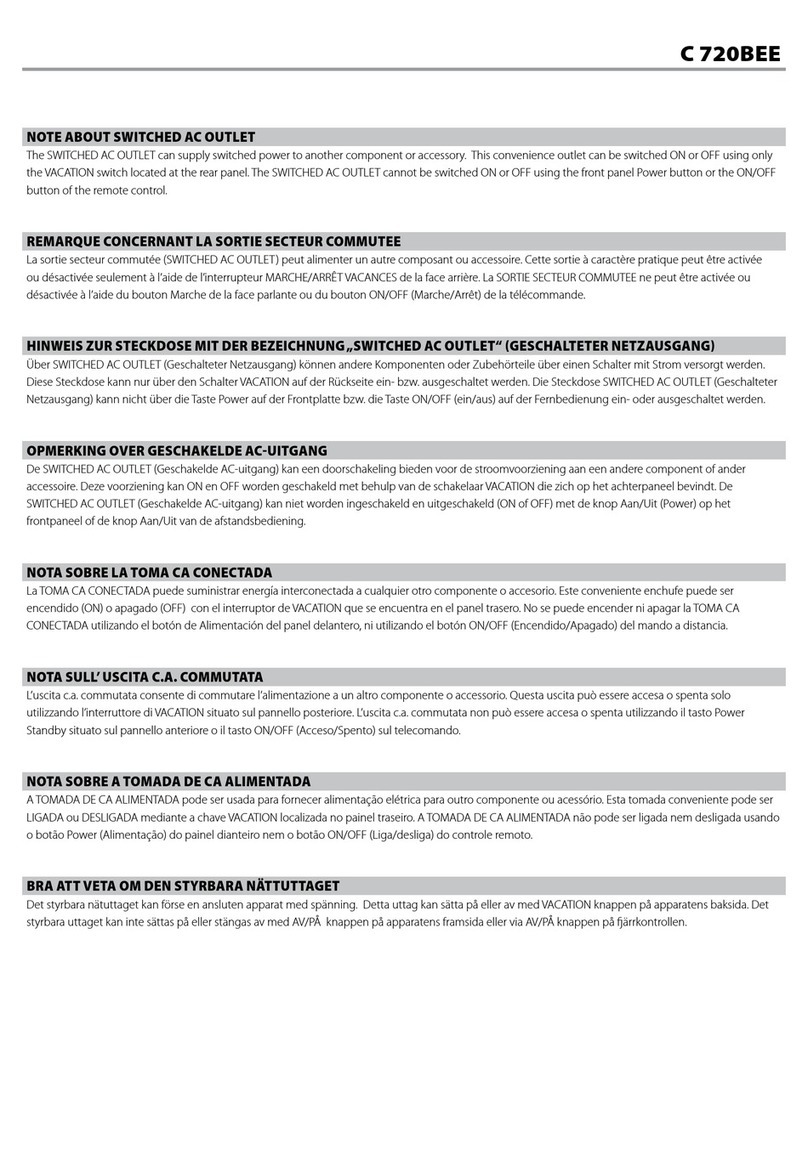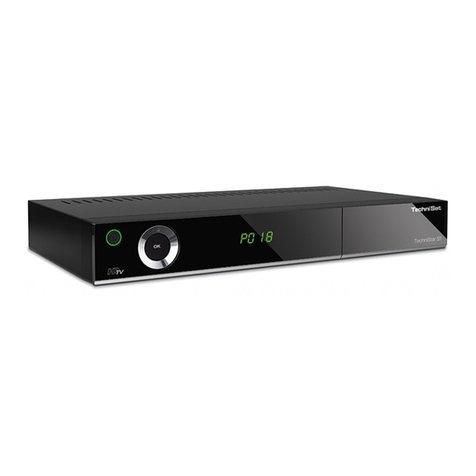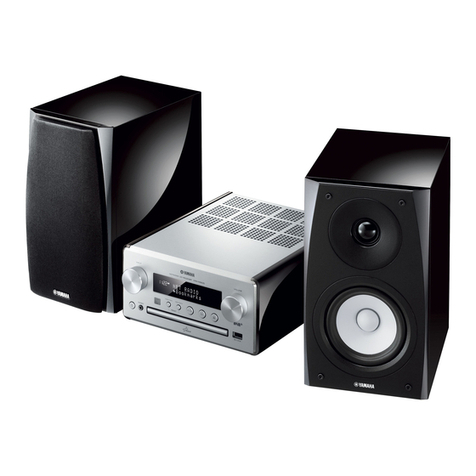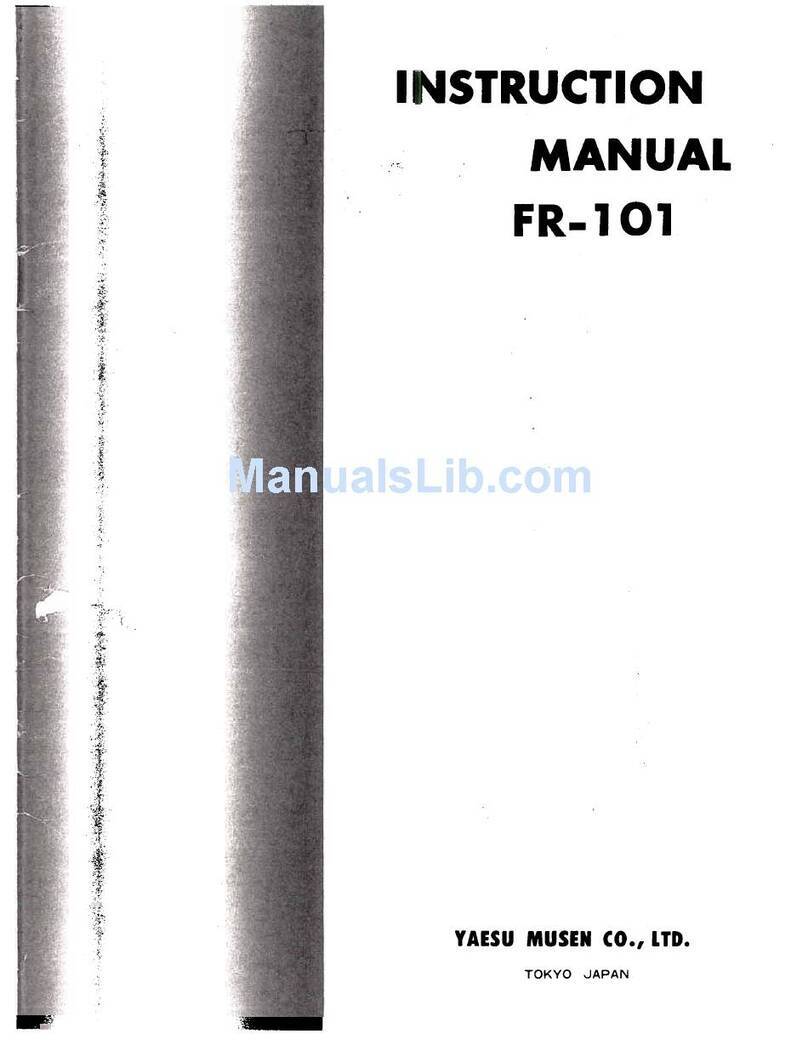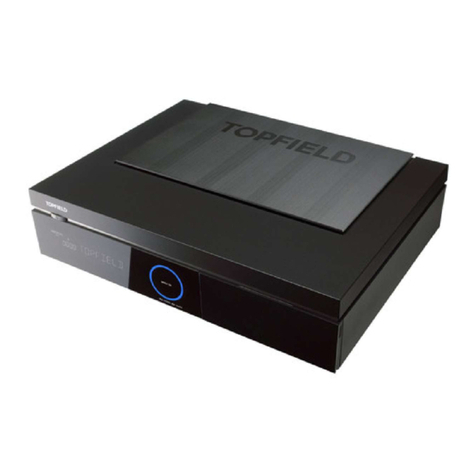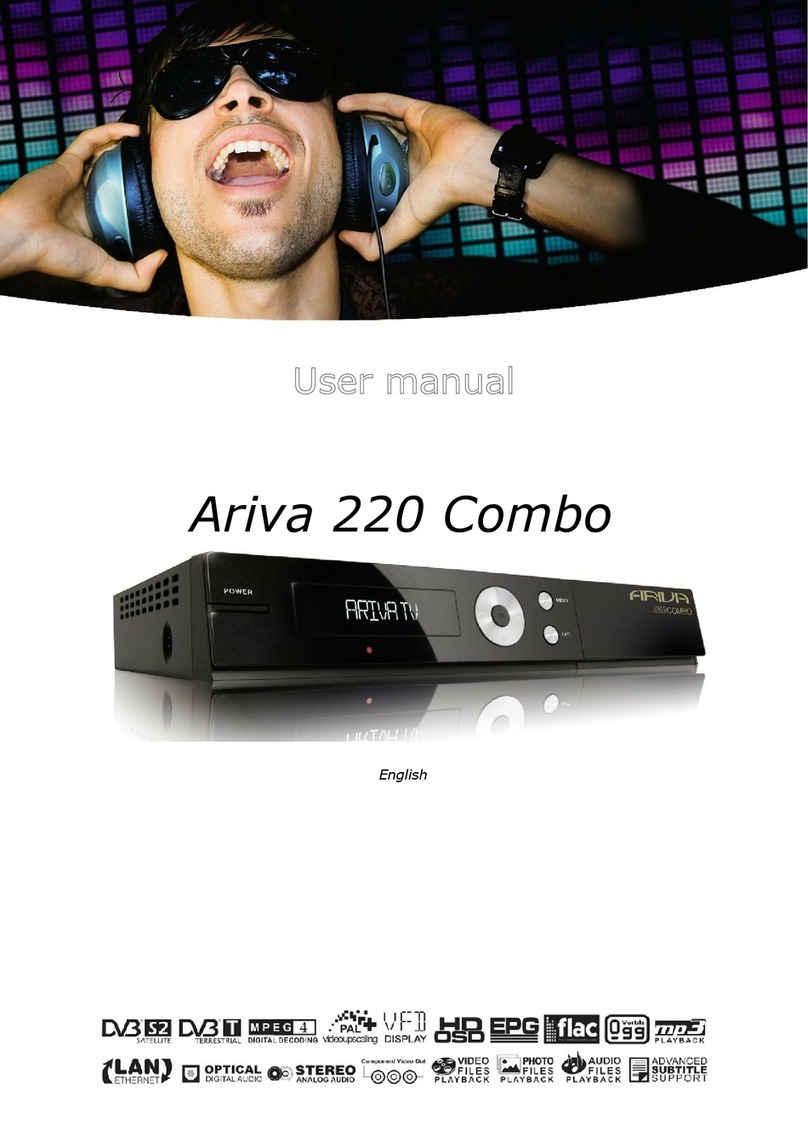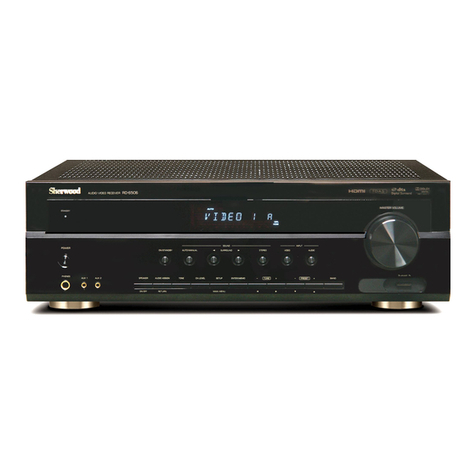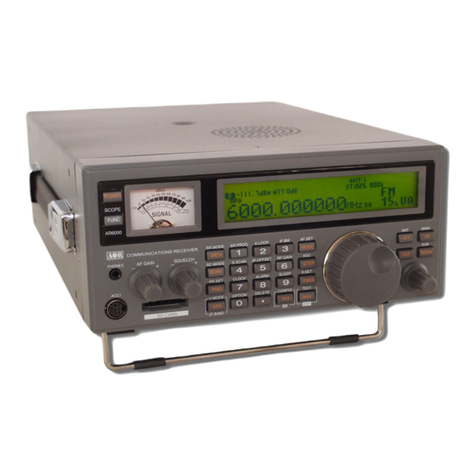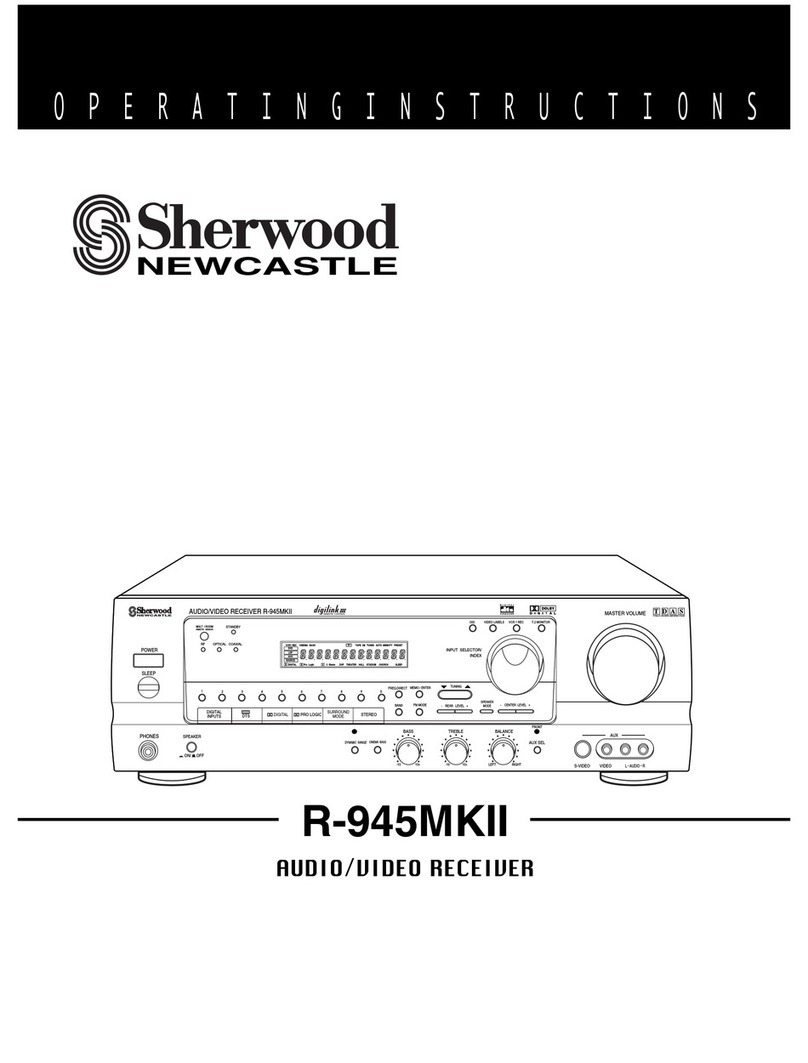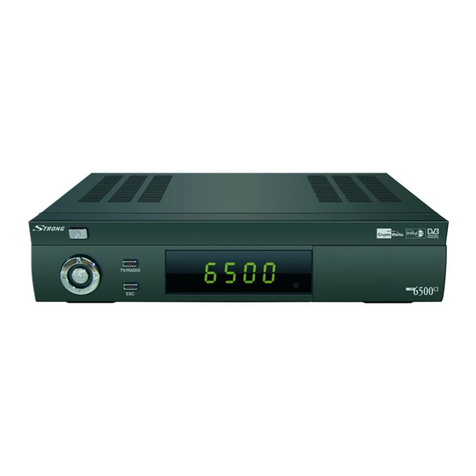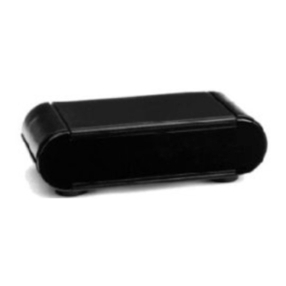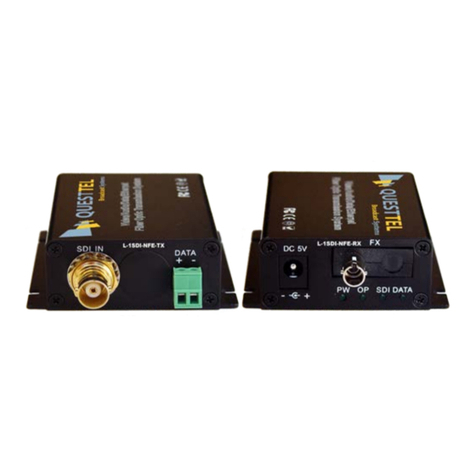Vertex Standard VR-120D Manual

1
©2002 VERTEX STANDARD CO., LTD. Printed in Japan.
Technical Supplement
VR-120D
Contents
Introduction
This manual provides technical information necessary for
servicing the Yaesu VR-120D Communications Receiver.
Information on its installation and operation can be found
in the VR-120D Operating Manual, which is provided with
the receiver, and Accessory information may be found in
the documents accompanying the optional equipment.
The VR-120D is a high-performance miniature
communications receiver providing general coverage
reception from 100 kHz to 1300 MHz on the AM, and FM
(Wide and Narrow bandwidths) modes (this coverage
includes the AM and FM broadcast bands, HF Short-wave
Bands up to 16 MHz, VHF and UHF TV bands, the VHF
AM aircraft band, and a wide range of commercial and
public safety frequencies!).
Servicing this equipment requires expertise in handling
surface mount chip components. Attempts by unqualified
persons to service this equipment may result in permanent
damage not covered by warranty. For the major circuit
boards, each side of the board is identified by the type of
the majority of components installed on that side. In most
cases one side has only chip components, and the other
has either a mixture of both chip and lead components
(trimmers, coils, electrolytic capacitors, packaged ICs, etc.),
or lead components only.
While we believe the technical information in this manual
is correct, VERTEX STANDARD assumes no liability for
damage that may occur as a result of typographical or
other errors that may be present. Your cooperation in
pointing out any inconsistencies in the technical
information would be appreciated. VERTEX STANDARD
reserves the right to make changes in this receiver and the
alignment procedures, in the interest of technological
improvement, without notification of owners.
Specifications ............................................................................................................................................... 2
Exploded View & Miscellaneous Parts ..................................................................................................... 3
Circuit Description ...................................................................................................................................... 5
Alignment ..................................................................................................................................................... 7
Block Diagram .............................................................................................................................................13
Board Unit (Schematics, Layouts & Parts)
CNTL•AF Unit ........................................................................................................................................................15
RF Unit ....................................................................................................................................................................23
COMMUNICATIONS RECEIVER VERTEX STANDARD CO., LTD.
4-8-8 Nakameguro, Meguro-Ku, Tokyo 153-8644, Japan
VERTEX STANDARD
US Headquarters
17210 Edwards Rd., Cerritos, CA 90703, U.S.A.
International Division
8350 N.W. 52nd Terrace, Suite 201, Miami, FL 33166, U.S.A.
YAESU EUROPE B.V.
P.O. Box 75525, 1118 ZN Schiphol, The Netherlands
YAESU UK LTD.
Unit 12, Sun Valley Business Park, Winnall Close
Winchester, Hampshire, SO23 0LB, U.K.
VERTEX STANDARD HK LTD.
Unit 5, 20/F., Seaview Centre, 139-141 Hoi Bun Road,
Kwun Tong, Kowloon, Hong Kong
EH011M90A
All manuals and user guides at all-guides.com
all-guides.com

12
Alignment
Note:
All manuals and user guides at all-guides.com

2
Specifications
Frequency Range: USA: 100 kHz ~ 1299.995 MHz (Cellular Blocked)
EXP: 100 kHz ~ 1299.995 MHz
(Frequency range is varied per local law. Ask your YAESU dealer
for details for frequency range in your country.)
Receiving Mode: AM/FM/WFM
Circuit Type: Triple Super-heterodyne
Memory Channels: 640 Channels
Memory Bank: 10 Banks (@ 64 Channels)
Antenna Impedance: 50-ohm unbalanced, BNC receptacle
Intermediate Frequencies: 248.45 MHz, 15 MHz, 450 kHz
Sensitivity (Typical): 200kHz ~ 5 MHz: AM 3.5 dBµ (1.5 µV)
5 ~ 160 MHz: AM -4.4 dBµ (0.6 µV)
FM -10.4 dBµ (0.3 µV)
WFM-1.0 dBµ (0.9 µV)
160 ~ 370 MHz: AM -4.4 dBµ (0.6 µV)
FM -10.4 dBµ (0.3 µV)
WFM-4.4 dBµ (0.6 µV)
370 ~ 520 MHz: FM -10.4 dBµ (0.3 µV)
WFM0 dBµ (1.0 µV)
520 ~ 1300 MHz: FM -3.0 dBµ (0.7 µV)
WFM9.5 dBµ (3.0 µV)
Selectivity: WFM: 200 kHz/-6 dB
AM/FM: 16 kHz/-6 dB
Conducted Spurious Emission: Less than -54 dBm
Supply Voltage: 2.2 ~ 3.5 V DC; Internal Battery (Nominal: 3.0 V DC)
5.5 ~ 10.0 V DC (EXT DC)
Current Consumption: Approx. 95 mA (Receive, AF Output 50 mW, 8-ohm)
Approx. 15 mA (Standby, Saver 1:4 on)
Approx. 55 mA (Standby, Saver off)
Operating Temp.: -10 °C ~ +50 °C
AF Output: Approx. 80 mW (8-ohm)
Case Size: 85 x 59 x 26 mm (H x W x D) w/o knob
Weight: Approx. 195 g w/battery & antenna
Specifications are subject to change without notice.
All manuals and user guides at all-guides.com

3
Exploded View & Miscellaneous Parts
No. VXSTD P/N DESCRIPTION QTY.
U07240307 PANHEAD SCREW M2x4B#3 2
U9900119 TAPTITE SCREW M2x5B#3 2
U07125301 PANHEAD SCREW M1.7x2.5#3 3
Â
À
Á
VXSTD P/N DESCRIPTION QTY.
S6000335 HAND STRAP 1
RA014370B BELT CLIP 1
U9900097
BINDING HEAD SCREW M3x5.5B
1
À
À
Á
Á
Â
Â
Â
S8001937
LCD PANEL (YAESU)
S8001931
ANTENNA PACKING
S8100999
ANTENNA
S8002007
FRONT CASE ASSY
(W/SP NET)
S8001941
VOLUME NUT
S8001942
NUTANTENNA
S8001930
SQL KNOB
S8001929
VOL KNOB
(W/SPRING)
S8001932
SQL GUM PACKING
S8001928
DIAL KNOB
(W/SPRING)
S8001938
BUTTON PLATE
S8001998
GUM PACKING
S8001934
RUBBER CONTACT
S8001000
SPEAKER
S8001958
LCD TAPE
S8001955
TAPE
S8002002
CONTACT C
S8002004
CUSHION
S8101164 (USA)
S8101165 (B1)
S8101166 (B2)
CNTL.AF Unit
S8100788
ANTENNA CONNECTOR
S8001939
WATER PROOF FILM
S8001999
FRAME
S8101168
RF Unit
S8101008
BAR ANTENNA ASSY
S8001736
CONTACT B
S8001947
CONTACT D
S8001996
REAR CASE
S8001944
BATTERY PACKING
S8001926
BATTERY COVER
S8001737
GUM CUSHION
S8001734
CONTACT C
S8001948
GUM CUSHION
S8001927
CLAMPER
S8002003
LIGHT SEAL
S8002005
RUBBER CONNECTOR
S8001954
REFLECT SHEET
S8001957
LCD FILE
S8001951
LCD BACK PLATE
S8101007
LCD
S8001952
LCD COVER
S8002001
CONTACT B
S8002000
CONTACT A
All manuals and user guides at all-guides.com

Exploded View & Miscellaneous Parts
4
Note:
All manuals and user guides at all-guides.com

5
Circuit Description
VR-120D separates into two substrate blocks. It is
RF unit and CNTL•AF unit.
ATT, ANT band path filter, bar ANT for AM,
RFAMP, 1st•2ndMIX, 2ndIF-AMP, 3rdIF-DETIC,
PLL, 1st•2nd-VCO, AMDET circuit are had by the
RF unit. Also, the CNTL•AF unit has a CPU, LCD,
a power, AUDIO circuit, EEPROM.
RF Unit
The signal which entered from ANT is stored in the
band path filter below the entering to the ATT
circuit.
It is amplified by RF-AMP Q216, Q217 which is
common after the band path filter passage.
The amplified RF signal entry to 1st-MIX Q218
(µPC2757T) with the 1st local signal, it makes a 1st
IF signal.
The 1st local oscillator is VCO Q241 (2SC5006). and
oscillated signal is amplified in the buffering in
Q240, Q239 (2SC5006).
The 1st-IF signal of 248.45MHz which passed the
SAW filter of F202 are input to 2nd-MIX Q219
(2SC5006), it mix with the 2nd local signal of
263.45MHz, and makes a 2nd-IF signal.
Amplifying the 2nd-IF in Q220 2SC4915, and It
detects and it gets a speech signal by IF IC of Q221
(TA31136FN).
3rd-IF is 450kHz. The AM detection is Q231
(UMX2N), it amplifies 3rd-IF signal and Q232
(RB520S-30) detects AM.
2nd-VCO is oscillated by Q229, and it is amplified
by Q228.
PLL IC is Q235 (MB15F02PFV). It forms 1st and
2nd PLL circuit.
The standard crystal oscillation circuit is Q234
(2SC4617), it oscillates 14.55 MHz crystal.
The loop filter for 1st local is Q236 (2SK1580), its
active type, and the loop filter for 2nd local is passive
type by CR.
CNTL•AF unit
The detected signal from the RF substrate, which is
amplified by Q130 (UMX2N), and volume
controlled signal amplified by Q123 (TA31056F),
and it outputs a sound from the speaker.
The DC input of 3V, which boosts the voltage to
3.5V by the DC-DC converter Q116
(XC6371A351PR). It is stabilized to 3.2 V by Q118
(S-81332HG-KC).
The main microprocessor is Q101 (HD643837S).
EEPROM is Q115 (AT24C64N-10SI1.8).
The reset IC is Q112 (RN5VL20AA).
The 10V boost circuit for RF VCO, which boosts
and detects by Q119, Q120, Q121 (RB706F).
Q122 (2SC4617R) is a ripple filter.
All manuals and user guides at all-guides.com
all-guides.com

6
Circuit Description
Note:
All manuals and user guides at all-guides.com

7
Alignment
Introduction
The VR-120D has been carefully aligned at the
factory for the specified performance across the
amateur band. Realignment should therefore not
be necessary except in the event of a component
failure. All component replacement and service
should be performed only by an authorized Vertex
Standard representative, or the warranty policy may
be voided.
The following procedures cover the sometimes
critical and tedious adjustments that are not
normally required once the transceiver has left the
factory. However, if damage occurs and some parts
are replaced, realignment may be required. If a
sudden problem occurs during normal operation,
it is likely due to component failure; realignment
should not be done until after the faulty component
has been replaced.
We recommend that servicing be performed only
by authorized Vertex Standard service technicians
who are experienced with the circuitry and fully
equipped for repair and alignment. Therefore, if a
fault is suspected, contact the dealer from whom
the transceiver was purchased for instructions
regarding repair. Authorized Vertex Standard
service technicians realign all circuits and make
complete performance checks to ensure compliance
with factory specifications after replacing any faulty
components. Those who do undertake any of the
following alignments are cautioned to proceed at
their own risk. Problems caused by unauthorized
attempts at realignment are not covered by the
warranty policy. Also, Vertex Standard must reserve
the right to change circuits and alignment
procedures in the interest of improved performance,
without notifying owners. Under no circumstances
should any alignment be attempted unless the
normal function and operation of the transceiver
are clearly understood, the cause of the malfunction
has been clearly pinpointed and any faulty
components replaced, and the need for realignment
determined to be absolutely necessary.
Required Test Equipment
The following test equipment (and thorough
familiarity with its correct use) is necessary for
complete realignment. Correction of problems
caused by misalignment resulting from use of
improper test equipment is not covered under the
warranty policy. While most steps do not require
all of the equipment listed, the interactions of some
adjustments may require that more complex
adjustments be performed afterwards. Do not
attempt to perform only a single step unless it is
clearly isolated electrically from all other steps. Have
all test equipment ready before beginning, and
follow all of the steps in a section in the order
presented.
rRF Signal Generator with calibrated output level
at 1300 MHz
rDeviation Meter
rFrequency Counter: ±0.1 ppm accuracy at 500
MHz
rDC Voltmeter: high impedance
rAF Dummy Load: 8-Ohms, 1W
Note: Signal levels in dB referred to in this procedure
are based on 0 dBµ = 0.5 µV (closed circuit).
Alignment Preparation & Precautions
Correct alignment requires that the ambient
temperature in the repair shop be the same as that
of the receiver and test equipment, and that this
temperature be held constant between 20 °C and
30 °C (68° ~ 86° F). When the receiver is brought
into the shop from hot or cold air it should be
allowed some time for thermal equalization with
the environment before alignment. If possible,
alignments should be made with oscillator shields
and circuit boards firmly affixed in place. Also, the
test equipment must be thoroughly warmed up
before beginning.
All manuals and user guides at all-guides.com

8
Alignment
Test Setup
Set up the test equipment as shown below for
receiver alignment.
PLL Reference Frequency Adjustment
rDisable the Battery Save;
mPress the [SCN] key while press and holding
the [FUNC] key.
mRotate the DIAL knob to select the display to
"SAVE."
mRotate the DIAL knob while press and holding
the [FUNC] key to change the display to "OFF."
mPress the [V/M] key to disable the battery saver
and exit to normal operation.
rConnect the Frequency Counter to TP1, and set
the receiver to 100.050 MHz, NFM mode.
rAdjust C305, if necessary, so the counter
frequency is within ±200 Hz of 348.500 MHz.
RF Voltage
rConnect the DC voltmeter to TP2, and confirm
DC voltmeter reading 3.05~3.25V.
VCO VCV
rConnect the DC voltmeter to TP3, and referring
to table below, tune the VR-120D to each
frequency listed.
Then confirm that the correct voltage is present.
FM Discriminator Adjustment
rConnect the AF Milivoltmeter and 8-ohm resistor
to the SP jack, and connect the RF Signal
generator (SSG) to ANT jack.
rSet the receiver to 100.020 MHz, NFM mode.
rTune the SSG to 100.200 MHz with ±3.5 kHz
deviation ±1 kHz tone modulation, and set the
output level to 60 dBµ.
rAdjust L229 for maximum indication on the AF
Milivoltmeter.
SQL Level/S-Meter Adjustment
Preparation
rSet the receiver to 1250.375 MHz, NFM mode,
then disable the OFF-timer function and set the
ATT to OFF.
rPress and hold the [SCAN] key for 2 seconds,
the rotate the DIAL knob to select the display to
"SL."
rPress and hold the [SCAN] key for 2 second while
press and holding the [FUNC] key. "LOW W "
will appears on the display. Sounds a beep.
rTune the receiver to 123.125 MHz.
rPress and hold the [SCAN] key for 2 seconds,
the rotate the DIAL knob to select the display to
"SS."
rPress and hold the SCAN key for 2 second while
press and holding the [FUNC] key. "ST W " will
appears on the display. Sounds a beep.
Frequency VCV Voltage
0.500 MHz 0.15V ~ 0.55V
116.455 MHz 6.30V ~ 8.60V
116.550 MHz 0.12V ~ 0.60V
1299.950 MHz 5.40V ~ 6.60V
AF Dummy Load
8-Ohms, 1W
Frequency Counter
RF Sinal Generator
SINAD Meter
Regulated
6.0V PSU
All manuals and user guides at all-guides.com

9
Alignment
C305
PLL Reference Frequency Adjust
TP3
VCO VCV:
DC voltmeter
TP1
PLL Reference Frequency Adjust:
Frequency Counter
L229
FM Discriminator Adjust
TP2
RF Voltege:
DC voltmeter
Alignment Points
All manuals and user guides at all-guides.com

10
Alignment
rTune the receiver to 448.250 MHz.
rPress and hold the [SCAN] key for 2 seconds,
the rotate the DIAL knob to select the display to
"SU."
rPress and hold the [SCAN] key for 2 second while
press and holding the [FUNC] key. "SQL SET"
will appears on the display. Sounds a beep.
SQL Level Adjustment
NFM mode:
rConnect the RF Signal Generator to ANT jack.
rSet the receiver to 100.050 MHz, NFM mode.
rPress the [SCAN] key. "SQL" will appear on the
display.
rTune the SSG to 100.050 MHz with ±3.5 kHz
deviation @1 kHz tone modulation, and set the
output level to -12 dBµ.
rPress the [BND(p)] key while press and holding
[FUNC] key. "SQL SL" will appear on the display.
rPress the [V/M] key while press and holding
[FUNC] key. Sounds a beep.
rIncrease the SSG output level to 2 dBµ.
rPress the [SCAN] key while press and holding
[FUNC] key. "SQL TI" will appear on the display.
rPress the [V/M] key while press and holding
[FUNC] key. Sounds a beep.
rPress the [MODE] key while press and holding
[FUNC] key. "SQL CR" will appear on the
display.
rPress the [V/M] key while press and holding
[FUNC] key. Sounds a beep.
WFM mode:
rSet the receiver to 100.050 MHz, WFM mode.
rPress the [SCAN] key. "SQL" will appear on the
display.
rTune the SSG to 100.050 MHz with ±75 kHz
deviation @1 kHz tone modulation, and set the
output level to 2 dBµ.
rPress the [BND(p)] key while press and holding
[FUNC] key. "SQL SL" will appear on the display.
rPress the [V/M] key while press and holding
[FUNC] key. Sounds a beep.
rIncrease the SSG output level to 15 dBµ.
rPress the [SCAN] key while press and holding
[FUNC] key. "SQL TI" will appear on the display.
rPress the [V/M] key while press and holding
[FUNC] key. Sounds a beep.
rPress the [MODE] key while press and holding
[FUNC] key. "SQL CR" will appear on the
display.
rPress the [V/M] key while press and holding
[FUNC] key. Sounds a beep.
AM mode:
rSet the receiver to 1.050 MHz, AM mode.
rPress the [SCAN] key. "SQL" will appear on the
display.
rTune the SSG to 1.050 MHz with 30%
modulation @1 kHz tone, and set the output level
to -5 dBµ.
rPress the [BND(p)] key while press and holding
[FUNC] key. "SQL SL" will appear on the display.
rPress the [V/M] key while press and holding
[FUNC] key. Sounds a beep.
rIncrease the SSG output level to 8 dBµ.
rPress the [SCAN] key while press and holding
[FUNC] key. "SQL TI" will appear on the display.
rPress the [V/M] key while press and holding
[FUNC] key. Sounds a beep.
rPress the [MODE] key while press and holding
[FUNC] key. "SQL CR" will appear on the
display.
rPress the [V/M] key while press and holding
[FUNC] key. Sounds a beep.
S-Meter Adjustment
NFM mode:
rConnect the RF Signal Generator to ANT jack.
rSet the receiver to 100.050 MHz, NFM mode.
rPress the [BND(p)]. "S M ET" will appear on the
display.
rTune the SSG to 100.050 MHz with ±3.5 kHz
deviation @1 kHz tone modulation, and set the
output level to 20 dBµ.
All manuals and user guides at all-guides.com
all-guides.com

11
Alignment
rPress the [BND(p)] key while press and holding
[FUNC] key. "S M ET+ " will appear on the
display.
rPress the [V/M] key while press and holding
[FUNC] key. Sounds a beep.
rReduce the SSG output level to -5 dBµ.
rPress the [SCAN] key while press and holding
[FUNC] key. "S M ET2 " will appear on the
display.
rPress the [V/M] key while press and holding
[FUNC] key. Sounds a beep.
WFM mode:
rSet the receiver to 100.050 MHz, WFM mode.
rPress the [BND(p)]. "S M ET" will appear on the
display.
rTune the SSG to 100.050 MHz with ±75 kHz
deviation @1 kHz tone modulation, and set the
output level to 35 dBµ.
rPress the [BND(p)] key while press and holding
[FUNC] key. "S M ET+ " will appear on the
display.
rPress the [V/M] key while press and holding
[FUNC] key. Sounds a beep.
rReduce the SSG output level to 5 dBµ.
rPress the [SCAN] key while press and holding
[FUNC] key. "S M ET2 " will appear on the
display.
rPress the [V/M] key while press and holding
[FUNC] key. Sounds a beep.
AM mode:
rSet the receiver to 1.050 MHz, AM mode.
rPress the [BND(p)]. "S M ET" will appear on the
display.
rTune the SSG to 1.050 MHz with 30%
modulation @1 kHz tone, and set the output level
to 20 dBµ.
rPress the [BND(p)] key while press and holding
[FUNC] key. "S M ET+ " will appear on the
display.
rPress the [V/M] key while press and holding
[FUNC] key. Sounds a beep.
rReduce the SSG output level to 0 dBµ.
rPress the [SCAN] key while press and holding
[FUNC] key. "S M ET2 " will appear on the
display.
rPress the [V/M] key while press and holding
[FUNC] key. Sounds a beep.
Press the [V/M] key to save the new setting and
exit to the normal operation.
All manuals and user guides at all-guides.com

13
Block Diagram
All manuals and user guides at all-guides.com

14
Block Diagram
Note:
All manuals and user guides at all-guides.com

15
CNTL•AF Unit
Circuit Diagram
USA B1 B2
R113 --- 0 ---
All manuals and user guides at all-guides.com

16
CNTL•AF Unit
Note:
All manuals and user guides at all-guides.com
all-guides.com

17
CNTL•AF Unit
Side A
ABCDE
1
2
3
4
Parts Layout
RN5VL20A (B0)
(Q112)
UMG2N (G2)
(Q113)
DTA144EE (16)
(Q114)
DTC144EE (26)
(Q131, 142)
XC6371A351PR (A35)
(Q116)
TA31056F
(Q123)
2SA1588Y (ZY)
(Q124, 125, 128)
UMW1 (W1)
(Q126, 127)
UMX2N (X2)
(Q130)
1SS382 (A1)
(Q129)
XC6201P322PR (P32)
(Q118)
DTC123YE (62)
(Q139)
All manuals and user guides at all-guides.com

18
CNTL•AF Unit
Side B
edcba
1
2
3
4
HD6433837SD
(Q101)
1SS382 (A1)
(Q102, 103, 104)
2SC4617 (BR)
(Q107, 110)
RB706F-40T106 (3J)
(Q120, 121)
AT24C64N-10SI1.8SL722A
(Q115)
2SD1615 (GK)
(Q136)
All manuals and user guides at all-guides.com

19
CNTL•AF Unit
PCB with Component (W/ LCD ASS'Y, SHIELD CASE, CUSHION, CONTACT C) S8101164 USA
PCB with Component (W/ LCD ASS'Y, SHIELD CASE, CUSHION, CONTACT C) S8101165 B1
PCB with Component (W/ LCD ASS'Y, SHIELD CASE, CUSHION, CONTACT C) S8101166 B2
C101 CHIP CAP. 47pF 50V CH GRM39CH470J50PT K22174227 1-
C102 CHIP CAP. 47pF 50V CH GRM39CH470J50PT K22174227 1-
C103 CHIP CAP. 0.22uF 16V BGRM40B224M16PT K22120806 1-
C104 CHIP CAP. 0.33uF 10V BGRM188B11A334KA01D K22104802 1-
C105 CHIP CAP. 0.1uF 16V BGRM39B104K16PT K22124805 1-
C108 CHIP CAP. 0.001uF 50V BGRM39B102K50PT K22174821 1-
C109 CHIP CAP. 0.001uF 50V BGRM39B102K50PT K22174821 1-
C110 CHIP CAP. 0.1uF 16V BGRM39B104K16PT K22124805 1-
C111 CHIP CAP. 0.001uF 50V BGRM39B102K50PT K22174821 1-
C112 CHIP CAP. 0.01uF 25V BGRM39B103K25PT K22144803 1-
C113 CHIP TA.CAP. 10uF 6.3V TEMSVA0J106M-8R K78080027 1-
C114 CHIP CAP. 0.01uF 25V BGRM39B103K25PT K22144803 1-
C115 CHIP CAP. 0.01uF 25V BGRM39B103K25PT K22144803 1-
C116 CHIP TA.CAP. 33uF 10V TEMSVB21A336M-8R K78100047 1-
C118 CHIP CAP. 0.1uF 16V BGRM39B104K16PT K22124805 1-
C119 CHIP CAP. 0.1uF 16V BGRM39B104K16PT K22124805 1-
C120 CHIP CAP. 0.1uF 16V BGRM39B104K16PT K22124805 1-
C121 CHIP CAP. 0.1uF 16V BGRM39B104K16PT K22124805 1-
C122 CHIP CAP. 0.1uF 16V BGRM39B104K16PT K22124805 1-
C123 CHIP TA.CAP. 220uF 4V UZS0G221MCR1GB K48060006 1-
C124 CHIP CAP. 0.01uF 25V BGRM39B103K25PT K22144803 1-
C125 CHIP CAP. 0.1uF 16V BGRM39B104K16PT K22124805 1-
C127 CHIP CAP. 0.1uF 16V BGRM39B104K16PT K22124805 1-
C128 CHIP CAP. 0.1uF 16V BGRM39B104K16PT K22124805 1-
C129 CHIP TA.CAP. 220uF 4V UZS0G221MCR1GB K48060006 1-
C130 CHIP TA.CAP. 100uF 6.3V UZS0J101MCR1GB K48080009 1-
C131 CHIP CAP. 100pF 50V CH GRM39CH101J50PT K22174235 1-
C132 CHIP TA.CAP. 2.2uF 50V UWX1H2R2MCR1GB K48170010 1-
C133 CHIP TA.CAP. 4.7uF 25V UWX1E4R7MCR1GB K48140012 1-
C134 CHIP CAP. 0.027uF 16V RGRM39R273K16PT K22124802 1-
C135 CHIP CAP. 0.047uF 16V BGRM39B473K16PT K22124804 1-
C136 CHIP CAP. 0.1uF 16V BGRM39B104K16PT K22124805 1-
C137 CHIP CAP. 1uF 6.3V BGRM39B105K6.3PT K22084801 1-
C138 CHIP TA.CAP. 4.7uF 25V UWX1E4R7MCR1GB K48140012 1-
C139 CHIP CAP. 0.1uF 16V BGRM39B104K16PT K22124805 1-
C140 CHIP CAP. 0.027uF 16V RGRM39R273K16PT K22124802 1-
C141 CHIP CAP. 1uF 6.3V BGRM39B105K6.3PT K22084801 1-
C142 AL.ELECTRO.CAP. 10uF 16V UWX1C100MCR2GB K48120016 1-
C145 CHIP CAP. 0.1uF 16V BGRM39B104K16PT K22124805 1-
E101 SPEAKER K036NA500-35 S8101000 1-
J101 CONNECTOR 245047030400856 P1091121 1-
J102 CONNECTOR HSJ1501-010010 P1091068 1-
J103 CONNECTOR HEC3350-012110 P0091167 1-
L101 M.RFC MLF1608A1R0KT L1690930 1-
L102 M.RFC LB2016T4R7M L1691089 1-
L103 RF TRANS. S-167-3779 S8100775 1-
L104 M.RFC MLF1608A1R0KT L1690930 1-
L105 M.RFC MLF1608A1R0KT L1690930 1-
Q101 IC HD6433837SD53X S8101016 USA 1- b2
Q101 IC HD6433837SD48X S8101013 B1 1- b2
Q101 IC HD6433837SD48X S8101013 B2 1- b2
Q102 DIODE 1SS382(TE85R) G2070732 1- c3
Q103 DIODE 1SS382(TE85R) G2070732 1- c3
Q104 DIODE 1SS382(TE85R) G2070732 1- c3
Q105 LED AA1111C-640-TR S8101158 1- b3
Q106 LED AA1111C-640-TR S8101158 1- d3
Q107 TRANSISTOR 2SC4617 TL R G3346178R 1- c2
Q108 LED CL-220Y-C G2070830 1- d1
Q109 LED CL-220Y-C G2070830 1- d2
Q110 TRANSISTOR 2SC4617 TL R G3346178R 1- c2
Q112 IC RN5VL20AA-TR G1093071 1- D2
Q113 TRANSISTOR UMG2N TR G3070088 1- A2
Q114 TRANSISTOR DTA144EE TL G3070074 1- B1
Q115 IC AT24C64N-10SI1.8SL722A G1093171 1- b4
Parts List
DESCRIPTION VALUE V/W TOL. VXSTD P/NMFR’S DESIG VERS.REF. LOT. LAY ADR
All manuals and user guides at all-guides.com

20
CNTL•AF Unit
DESCRIPTION VALUE V/W TOL. VXSTD P/NMFR’S DESIG VERS.REF. LOT. LAY ADR
Q116 IC XC6371A351PR G1093343 1- D4
Q117 DIODE RB520S-30TE61 G2070822 1- D4
Q118 IC XC6201P322PR G1093624 1- D3
Q120 DIODE RB706F-40T106 G2070824 1- c4
Q121 DIODE RB706F-40T106 G2070824 1- c4
Q123 IC TA31056F(TP1) G1093070 1- C3
Q124 TRANSISTOR 2SA1588Y(TE85L) G3115888Y 1- C3
Q125 TRANSISTOR 2SA1588Y(TE85L) G3115888Y 1- C4
Q126 TRANSISTOR UMW1N TR G3070078 1- C4
Q127 TRANSISTOR UMW1N TR G3070078 1- D2
Q128 TRANSISTOR 2SA1588Y(TE85L) G3115888Y 1- D2
Q129 DIODE 1SS382(TE85R) G2070732 1- C3
Q130 TRANSISTOR UMX2N TR G3070254 1- D2
Q131 TRANSISTOR DTC144EE TL G3070075 1- B3
Q132 LCD MS-6217 S8101005 1- c2
Q134 DIODE RB520S-30TE61 G2070822 1- c4
Q135 DIODE SM4003A-T S8101159 1- b4
Q136 TRANSISTOR 2SD1615-T1 GK G3416158 1- a4
Q137 DIODE UDZS TE-17 4.3B G2070874 1- B4
Q138 DIODE RB520S-30TE61 G2070822 1- B4
Q139 DIODE DTC123YE TL G3070095 1- B4
Q140 DIODE EP05Q03L G2070734 1- C4
R101 CHIP RES. 4.7 1/16W 5% RMC1/16 4R7JATP J24185479 1-
R102 CHIP RES. 4.7 1/16W 5% RMC1/16 4R7JATP J24185479 1-
R103 CHIP RES. 10k 1/16W 5% RMC1/16 103JATP J24185103 1-
R104 CHIP RES. 6.8k 1/16W 5% RMC1/16 682JATP J24185682 1-
R105 CHIP RES. 47K 1/16W 5% RMC1/16 473JATP J24185473 1-
R106 CHIP RES. 120k 1/16W 5% RMC1/16 124JATP J24185124 1-
R107 CHIP RES. 470k 1/16W 5% RMC1/16 474JATP J24185474 1-
R108 CHIP RES. 2.2k 1/16W 5% RMC1/16 222JATP J24185222 1-
R109 CHIP RES. 47K 1/16W 5% RMC1/16 473JATP J24185473 1-
R110 CHIP RES. 1M 1/16W 5% RMC1/16 105JATP J24185105 1-
R111 CHIP RES. 1k 1/16W 5% RMC1/16 102JATP J24185102 1-
R112 CHIP RES. 1k 1/16W 5% RMC1/16 102JATP J24185102 1-
R113 CHIP RES. 01/16W RMC1/16 000JATP J24185000 B1 1-
R114 CHIP RES. 220k 1/16W 5% RMC1/16 224JATP J24185224 1-
R117 CHIP RES. 330k 1/16W 5% RMC1/16 334JATP J24185334 1-
R118 CHIP RES. 470k 1/16W 5% RMC1/16 474JATP J24185474 1-
R119 CHIP RES. 330k 1/16W 5% RMC1/16 334JATP J24185334 1-
R121 CHIP RES. 470k 1/16W 5% RMC1/16 474JATP J24185474 1-
R122 CHIP RES. 1k 1/16W 5% RMC1/16 102JATP J24185102 1-
R123 CHIP RES. 220k 1/16W 5% RMC1/16 224JATP J24185224 1-
R124 CHIP RES. 10k 1/16W 5% RMC1/16 103JATP J24185103 1-
R125 CHIP RES. 10k 1/16W 5% RMC1/16 103JATP J24185103 1-
R126 CHIP RES. 01/16W RMC1/16 000JATP J24185000 1-
R128 CHIP RES. 1k 1/16W 5% RMC1/16 102JATP J24185102 1-
R129 CHIP RES. 10k 1/16W 5% RMC1/16 103JATP J24185103 1-
R130 CHIP RES. 1M 1/16W 5% RMC1/16 105JATP J24185105 1-
R131 CHIP RES. 1k 1/16W 5% RMC1/16 102JATP J24185102 1-
R132 CHIP RES. 10k 1/16W 5% RMC1/16 103JATP J24185103 1-
R133 CHIP RES. 4.7k 1/16W 5% RMC1/16 472JATP J24185472 1-
R134 CHIP RES. 150k 1/16W 5% RMC1/16 154JATP J24185154 1-
R135 CHIP RES. 2.2k 1/16W 5% RMC1/16 222JATP J24185222 1-
R136 CHIP RES. 10k 1/16W 5% RMC1/16 103JATP J24185103 1-
R137 CHIP RES. 100 1/16W 5% RMC1/16 101JATP J24185101 1-
R138 CHIP RES. 01/16W RMC1/16 000JATP J24185000 1-
R139 CHIP RES. 2.2k 1/16W 5% RMC1/16 222JATP J24185222 1-
R140 CHIP RES. 330 1/16W 5% RMC1/16 331JATP J24185331 1-
R141 CHIP RES. 1.8k 1/16W 5% RMC1/16 182JATP J24185182 1-
R142 CHIP RES. 10k 1/16W 5% RMC1/16 103JATP J24185103 1-
R143 CHIP RES. 100 1/16W 5% RMC1/16 101JATP J24185101 1-
R144 CHIP RES. 10k 1/16W 5% RMC1/16 103JATP J24185103 1-
R145 POT. TP96D255-19F-B104XA103 S8101004 1-
R146 CHIP RES. 220k 1/16W 5% RMC1/16 224JATP J24185224 1-
R147 CHIP RES. 1k 1/16W 5% RMC1/16 102JATP J24185102 1-
R148 CHIP RES. 1k 1/16W 5% RMC1/16 102JATP J24185102 1-
R149 CHIP RES. 1k 1/16W 5% RMC1/16 102JATP J24185102 1-
All manuals and user guides at all-guides.com
Table of contents
Other Vertex Standard Receiver manuals
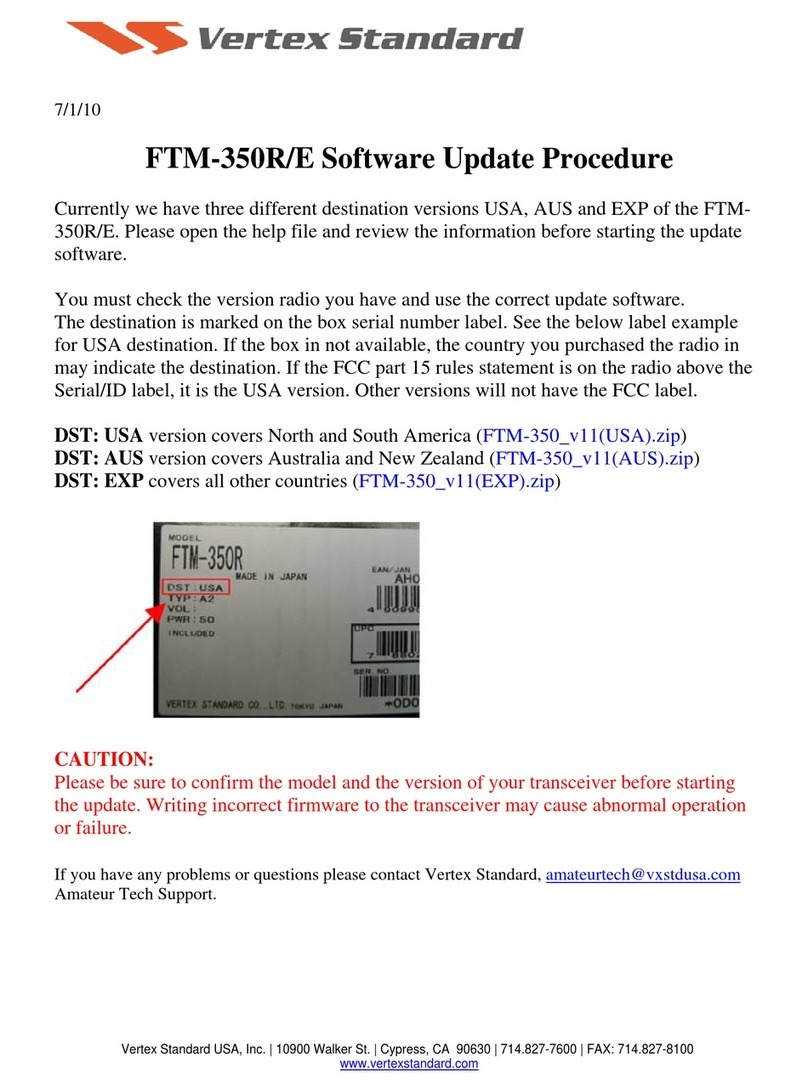
Vertex Standard
Vertex Standard FTM-350R - SOFTWARE UPDATE PROCEDURE 7110 Technical manual
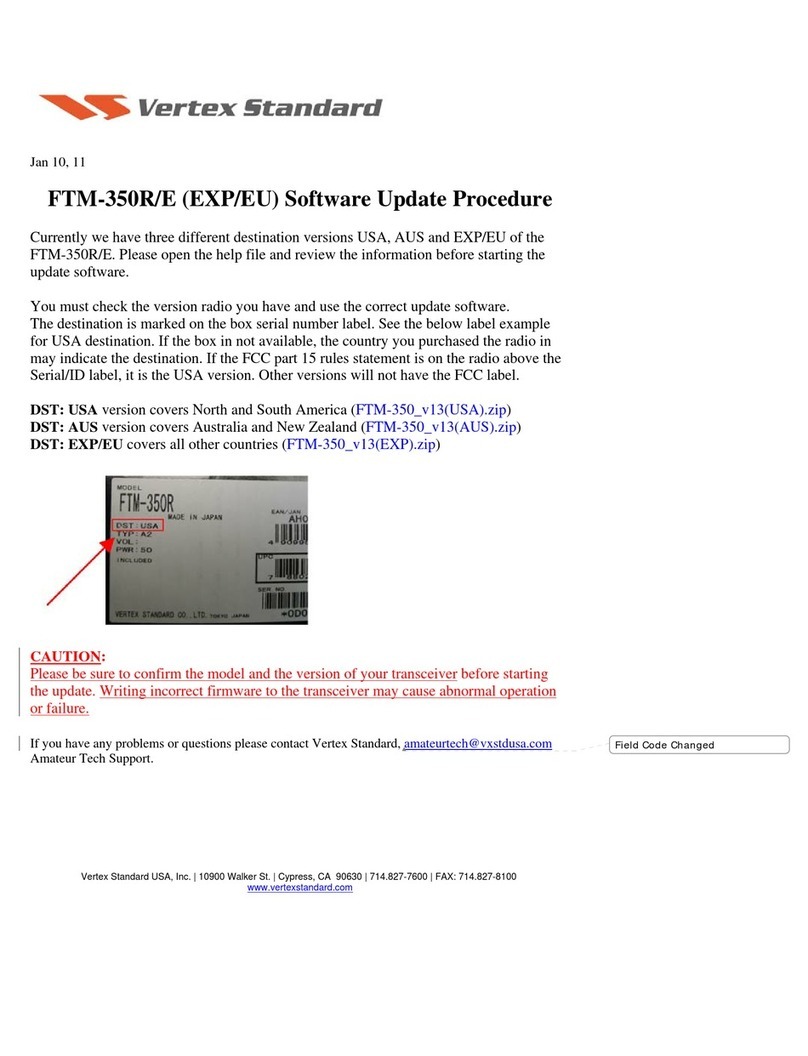
Vertex Standard
Vertex Standard FTM-350R-E - SOFTWARE UPDATE PROCEDURE... Technical manual
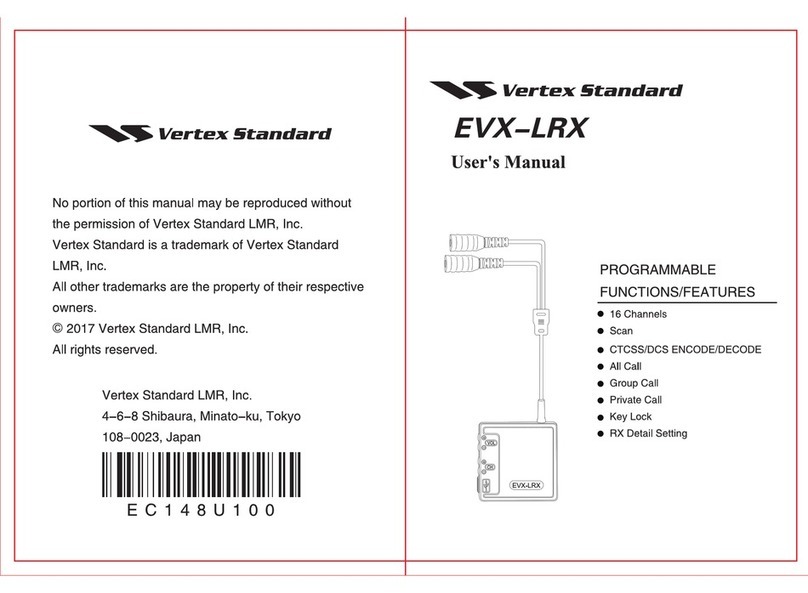
Vertex Standard
Vertex Standard EVX-LRX User manual

Vertex Standard
Vertex Standard FTM-350R-E - SOFTWARE UPDATE PROCEDURE Technical manual
